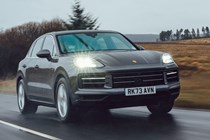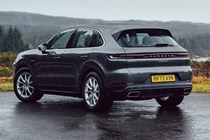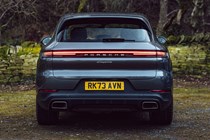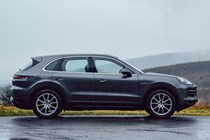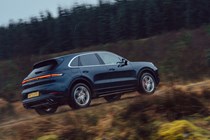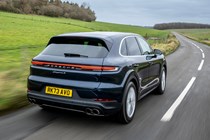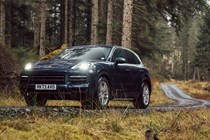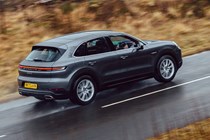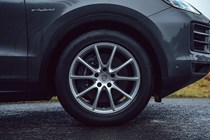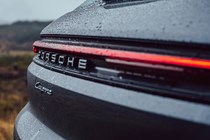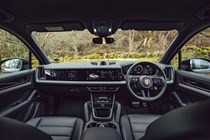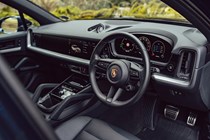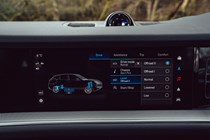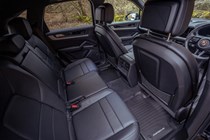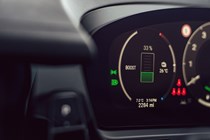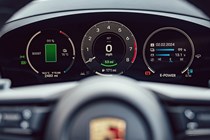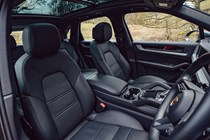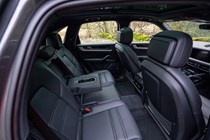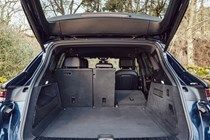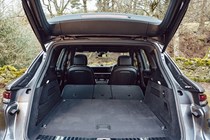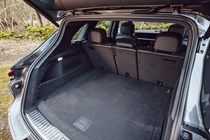
Porsche Cayenne engines, drive and performance
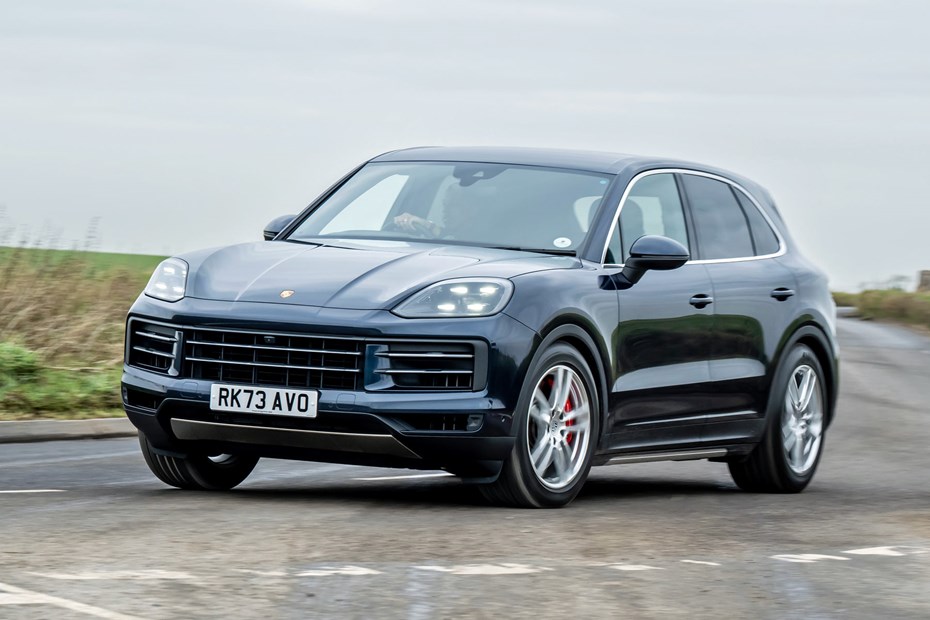
- V6, V8, and plug-in hybrids
- No diesel or 100% electric
- Frugal to ferocious – in the same version
Petrol engines
Following the 2023 facelift, the conventional engine range in the third-generation Porsche Cayenne is limited to the 3.0-litre turbocharged V6 in the entry-level Cayenne and the 4.0-litre turbocharged V8 in the non-hybrid Cayenne S. Everything else is now an E-Hybrid model, and we’ll get to these in a bit.
The Cayenne V6 produces 353hp and 500Nm of torque (pulling power). It’s good for 0-62mph in 5.7 seconds and a top speed of 154mph. If you crave nothing more than a premium SUV with a great interior, loads of cachet and a beautifully well-mannered – even involving – driving experience, this is a superb choice. And substantially less expensive than more potent variants.
However, prior to the introduction of the full range of E-Hybrids in October 2023, most UK buyers opted for the Cayenne S. The bigger engine not only provides a substantial injection of performance – with 474hp and 600Nm of torque, it does 0-62mph in 4.7 seconds and 170mph – it also has the enthusiast kudos of that eight-cylinder configuration.
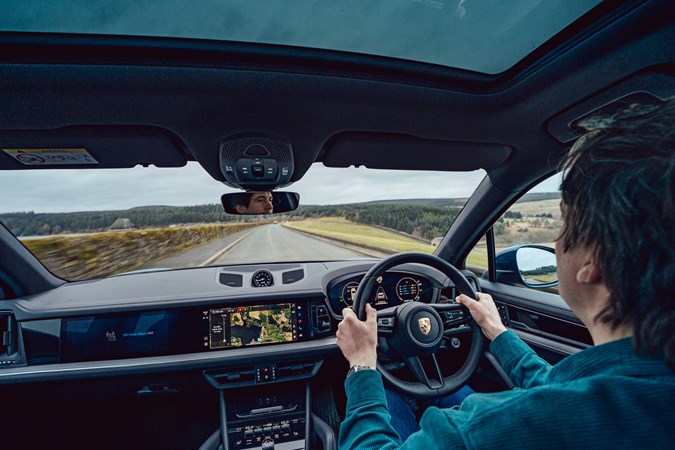
Supported by an addictively bassy soundtrack, we can certainly understand why customers would go for this while such things are still available. The ban on internal combustion engines may hang in the air at the moment, but it’s coming, and you still sense a Cayenne V8 is on borrowed time in the grand scheme of things.
So while the difference in performance between these two variants is negligible in everyday driving – the Cayenne S only definitively showing its advantage when travelling flat out – there’s still plenty of satisfaction to be had from the muscular presence of that bigger unit.
Plug-in hybrid engines
There are now three E-Hybrid versions of the Porsche Cayenne, each benefitting from a larger 29.5kWh lithium-ion battery pack and a more powerful 176hp electric motor integrated into the gearbox. This alone produces 450Nm of torque, and can propel these plug-in hybrids to 84mph all by itself while also significantly improving energy recuperation for greater efficiency.
The difference between the three comes from the associated petrol engine. The entry-level Cayenne E-Hybrid uses a 304hp version of the 3.0-litre V6 turbo. Combined total system output is 470hp and 650Nm. Which means that despite weighing 370kg more than the regular V6 Cayenne it still manages to do 0-62mph in 4.9 seconds. The transition between electric and petrol power is seamless, and with the ability to waft silently for up to 48 miles at a time, it’s a capable, premium eco-SUV choice.
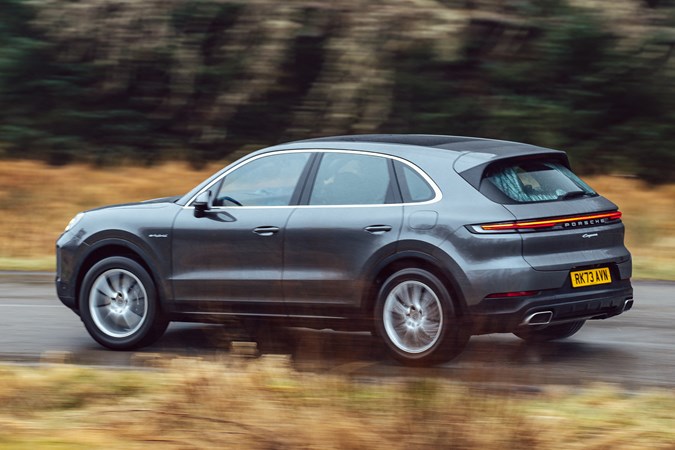
The Cayenne S E-Hybrid winds the V6 up to the same 353hp as the non-hybrid model, giving it a total system output of 519hp and 750Nm of torque. This trims the 0-62mph time back down to 4.7 seconds but more pressingly delivers mighty mid-range and top-end performance. The result is a 2.5-tonne SUV you can hustle along a twisting mountain road with scarcely believable conviction.
The Cayenne Turbo E-Hybrid, however, operates at an entirely different level of performance. This packs a 599hp 4.0-litre V8 turbo under the bonnet, creating Porsche’s most powerful Cayenne ever. Combined system output is 739hp and 950Nm of torque. It’ll do 0-62mph in 3.7 seconds, leaving a vast array of conventional sports cars in its wake.
The extra weight in the nose means it isn’t quite as agile as the S E-Hybrid, but you can easily make up for this whenever the road is vaguely straight. The four-wheel drive system standard on all Cayennes is capable of delivering enormous traction, even under this level of duress.
What’s it like to drive?
- Assured handling, huge performance
- Optional active anti-roll and rear-wheel steering
- Drive modes to tailor the experience
The Porsche Cayenne is hard to beat if you’re an enthusiastic driver after a large SUV – even the otherwise impressive BMW X5 struggles to reward the driver anywhere near as much. And though the Cayenne shares its underpinnings with the Audi Q7 and Bentley Bentayga, you’d be hard-pressed to tell given the degree to which they have been redeveloped to suit Porsche’s standards.
The steering is well weighted and precise, while regardless of whether your Cayenne is fitted with conventional steel springs or air suspension it will deal well with bumps and remain poised in corners. Though this can come at the cost of a slightly firm ride. Adaptive damping can help take the edge off this, but a Bentayga is ultimately more comfortable.
Refinement is more than acceptable for the most part, though you will hear more road noise on the motorway due to the large size of the wheels. All of the petrol engines sound good when worked hard – in keeping with that performance car brief – while the E-Hybrids also offer silent running thanks to their useful electric-motor-only driving range.
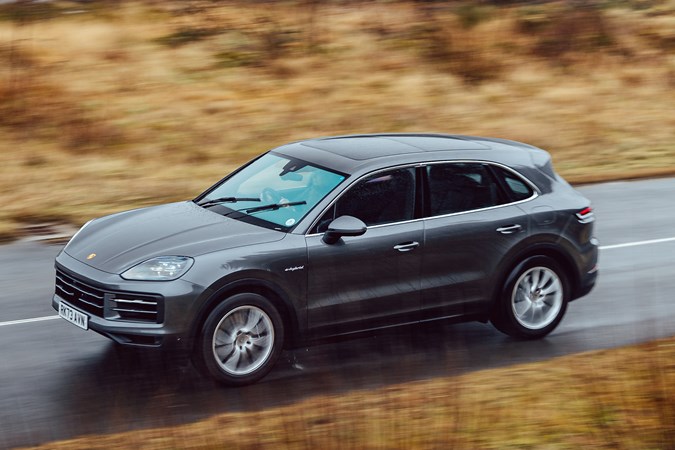
We’ve lapped a racing circuit in the most powerful E-Hybrid versions as a demonstration of this prowess. Despite being so big and heavy, everything feels tight and controlled, and there’s enough information coming through the steering wheel to give you confidence and a feeling of stability. If you dive into the options list for some of the more advanced chassis enhancements, this agility can be improved upon significantly.
These include not only the adaptive suspension (Porsche Active Suspension Management – PASM) but also an active anti-roll system (Porsche Dynamic Chassis Control – PDCC) to reduce lean in the corners, torque vectoring for the back axle (Porsche Torque Vectoring Plus – PTV Plus) that helps transfer power to the rear wheel with the most grip, and rear-axle steering.
This last allows the back wheels to steer slightly in tandem with the fronts. Below 50mph it makes the Cayenne more agile, able to turn in a smaller area because the rear wheels turn the opposite way to the fronts. Above 50mph both sets of wheels steer in the same direction, which increases high-speed cornering stability.
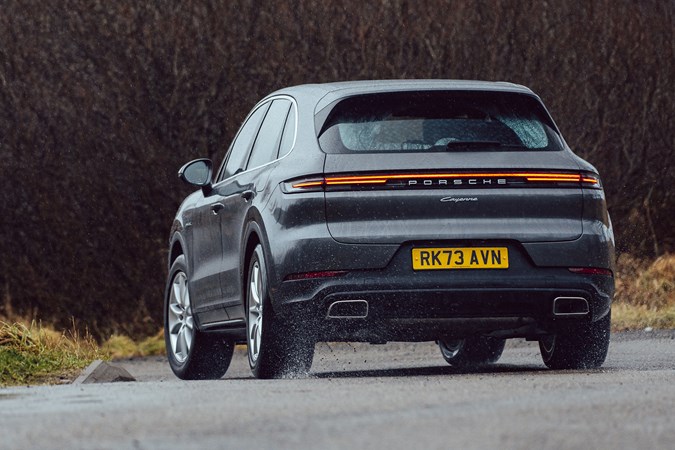
Even with all these systems fitted, the Cayenne still feels remarkably natural to drive. The only issue we experienced was a tiny amount of slack in the steering on the motorway, which can become a little tiring as it makes it seem as if you constantly have to make micro corrections. Strange, but entirely liveable given the rest of the driving experience.
Driving modes can be selected using a neat rotary control on the steering wheel. Go for the extra-cost Sport Chrono Package, and this is enhanced with an additional Sport Plus mode and a Sport Response button in the middle of the controller that summons maximum performance for 20 seconds, regardless of which mode you’re currently in.
Every Cayenne gets an eight-speed automatic transmission as standard, labelled Tiptronic S. This is smooth in its default setting, but select Sport or Sport Plus, and the changes get far quicker and more abrupt. You can use wheel-mounted paddle-shifters, with very little of the lack of response some other cars exhibit. But at its most aggressive it can be keener to downshift than we are, so you might find you go quicker leaving it to its own devices.


